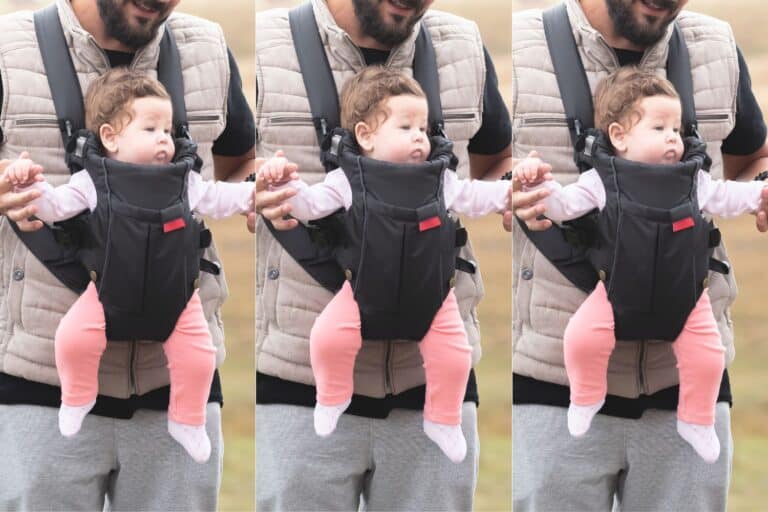A Complete Beginner’s Guide To Baby-Led Weaning

If you’ve ever seen a baby dive in for a bit of their parent’s food or swipe food off a plate, you know that a baby naturally wants to feed themselves. Learning to feed oneself is a basic human instinct, so some babies don’t like being spoon-fed.
Babies have been feeding themselves since humans have existed, sometimes accidentally, other times purposefully. Hence there are some who want to lean into this and develop a baby’s natural instincts to feed. The term “baby-led weaning” (BLW) was first coined in 2005 by food author Gill Rapley.
What Is Baby-Led Weaning?
Baby-led weaning, also known as auto-weaning, is an approach to introducing solid foods that puts your baby in control. It encourages self-feeding, meaning you offer soft finger foods to the baby, and they decide how much or little they want to eat.
The BLW approach is an alternative to the most common feeding method, spoon-feeding pureed foods. It has gained popularity over more traditional methods in the last two decades.
The Benefits of Baby-Led Weaning
If you’re considering BLW, here are the potential benefits for you and your baby.
1. Builds Critical Developmental Skills
BLW helps babies develop essential fine motor skills such as hand-eye coordination, chewing, and swallowing.
2. Exposes Baby to a Variety of Flavors and Textures
Exposing babies to a large variety of foods can stop picky eaters in their tracks. Most parents are surprised by what foods their baby is willing to try and like when they get to explore.
3. Fewer Mealtime Battles
When you spoon-feed your baby, you may have to resort to force-feeding, which makes for very frustrating mealtimes. Allowing them to feed themselves can encourage a more positive relationship with food.
4. Ditch The Headache of Purees and Pre-Packaged Baby Foods
BLW saves both money and time. There’s no need to cook separate meals or make homemade baby food; you can simply offer the same foods you are eating as a family in appropriate portions and shapes. (Note: you may need to remove the baby’s part before adding salt.)
5. Enjoy Your Meal With Baby
Many parents find BLW more enjoyable for sharing a meal, especially since everyone can eat simultaneously. It also helps the baby understand the importance of socialization during mealtimes too.
6. Lower Risk of Obesity
BLW encourages babies to learn their signals for hunger and fullness. Recognizing these cues helps build healthy eating habits for self-regulation, which is vital for long-term health. It can also reduce the risk of obesity from overeating or negative food associations.
The Risks of Baby-Led Weaning
Knowing the potential risks of BLW is essential when weighing up whether this is the right feeding style for your baby.
1. Parents Are Often Concerned About Choking
Choking is the biggest concern for parents. However, if done correctly and with proper supervision, the risk of choking is not higher for BLW.
2. The BIG Mess
BLW can be messy and requires plenty of patience and willingness to clean up. Yet, many parents find it’s worth it.
3. Nutritional Concerns
BLW does require parents to pay extra attention to their baby’s nutritional needs. There is often a concern specifically about iron and zinc deficiencies. However, these have not been validated by research.
4. Food Waste
It’s important to remember that babies will only finish some of what you give them. They may take just one bite and then decide they’re done. Food waste when a baby is eating is perfectly normal, but it can cause stress for some parents.
Signs Your Baby Is Ready To Try Feeding Themselves
When you introduce solid food to your baby, there are sure signs they may be ready for BLW.
- Can sit up unassisted
- Have good head and neck control
- Show an interest in food
- Make a chewing motion (mimicking you as you eat)
- They are attempting to reach out and grab food
Getting Started
If your baby appears ready to try baby-led weaning, follow these steps.
- Set a pace you’re comfortable with. There is no specific amount of food or a number of meals per day that your baby has to feed themselves. For young babies (6 to 9 months), you’ll likely start with just one meal per day. Then, progress to two meals and beyond from there.
- Establish a safe place for the baby to eat. Ensure your baby is seated upright in a high chair with a tray table that won’t tip. Make sure to sit near them and monitor them as they eat.
- Be patient. Remember, it will probably take your baby some time to learn how to feed themselves. Don’t get discouraged if they don’t eat much at first.
- Learn how to cut baby foods for maximal enjoyment and safety. You’ll want to make sure that the foods offered are soft enough for them to bite and chew. The best finger foods need to be cut into long wide wedges or cylindrical shapes so that they are easy to grasp and bite.
- Avoid tiny round foods. Foods like grapes, blueberries, and cherry tomatoes are choking hazards (cut them into wedges).
- Be aware of potential allergens. Before introducing potentially allergenic foods to your baby, speaking with their pediatrician about when it is safe is best. If introducing potential allergens, only introduce one food item at a time.
- Let the baby have fun with age-appropriate tools. As your baby learns to feed themselves, introduce baby-friendly spoons, forks, and other devices designed to easily scoop up thick puree.
- Provide appropriate foods. The key is offering your baby age-appropriate food (see ideas below) and knowing which foods to avoid with BLW.
The Best First Foods To Get Baby Started
You probably have many foods babies can eat in your fridge and pantry. You can also add a few new items to your grocery list for the next time you go shopping.
Here are some great ideas for baby’s first foods with BLW.
Animal Products
Babies tend to love meat, cheese, and eggs. Try to choose cuts of meat on the fattier side that are cooked to fall apart for easy chewing. Examples include:
- Chicken
- Lamb
- Shredded beef
- Scrambled or boiled eggs
- Wedges of cheese
Fruits
Ripe fruits are an easy win for babies, thanks to their sweetness. You can also throw fruits in a smoothie for exposure to the flavors.
- Banana
- Ripe avocado (expert tip: cut in wedges with the skin on the bottom half or roll in panko crumbs or hemp seeds for easier handling)
- Roasted apple wedges
- Melon
- Halved frozen blueberries (great for teething)
Veggies
Feel free to experiment with seasoning for flavor when offering baby vegetables. For example, add cumin, paprika, or turmeric to their cooked veggies for a new flavor profile.
- Roasted sweet potato wedges
- Steamed or roasted broccoli florets, cauliflower, and carrots
- Sauteed green beans
- Fried or baked zucchini wedges
Other Foods
Don’t be afraid to get creative and offer your baby the same foods you and your family already like.
- Toast (covered with avocado, cheese spread, or nut butter when baby is ready to try it)
- Mashed potatoes with butter
- Noodles or zoodles (zucchini noodles)
- Organic fried tofu cubes
- Oatmeal with fruit
- Grated cheese sprinkled over vegetables
- Baby pancakes (literally a mashed banana and egg mixed and fried in a pan)
- Beans (smashed to prevent choking)
- Rice (brown or white)
- Cereal that quickly dissolves in baby’s mouth
Pre-Packaged Options
There are some great pre-packed options if you’re looking for easy options when the baby doesn’t like what the family is eating or you’re on the go. Of course, these tend to be more costly than other options.
- Organic baby food pouches (as is or add them to oatmeal, rice, etc.)
- Soft, salt-free crackers
- Squeezable yogurt tubes (watch for hidden sugar)
- Pureed fruit and vegetable bars
- Cereal puffs and chickpea puffs that are designed for babies and toddlers
Baby-Led Weaning FAQs:
Now that you have all the basics down, let’s review some final commonly asked questions from parents.
When Should I Start Baby-Led Weaning?
The American Academy of Pediatrics recommends waiting until your baby is six months old before starting solid foods. Before then, only breastmilk or infant formula should be given to the baby. Waiting ensures that their digestive system is mature enough to handle the food. However, if the baby isn’t showing interest or can’t sit up yet, parents may wait until closer to 9 to 12 months.
How Do I Know if My Baby Is Ready for BLW?
When your baby shows signs of interest in finger foods and can sit independently, he or she is likely ready for BLW.
Do Babies Need Teeth for BLW?
No, babies don’t need teeth for BLW. They can gum and suck the food they are eating. This is why it needs to be soft and easily mashable.
Is Baby-Led Weaning Safe?
Yes, baby-led weaning is safe when the parent takes the necessary precautions. When introducing foods, start with soft, easily washable foods, like avocado or banana, cut and cooked to the right size. Never leave your baby alone while eating; always watch for choking hazards.
My Baby Keeps Gagging. Should I Stop BLW?
It’s important to understand that a gagging baby is good; their reflex works and will prevent them from choking as they learn to eat.
When Should I Introduce Allergens?
Introducing allergens early is important when it comes to baby-led weaning. While there is no definitive answer on the best time, starting slowly at 6 to 8 months is recommended. Talk to your pediatrician about any concerns, and introduce the allergen one at a time, in small amounts. Remember, no honey before one year of age due to contamination concerns.
How Do I Actually Start Baby-Led Weaning?
Keep it simple for the baby. Most parents like to start with easy wins they already have, such as a ripe banana or steamed vegetables.
How Do I Know The Baby Is Eating Enough?
BLW experts say babies mostly experiment with food in their first year. They likely won’t eat a ton at first. That’s why you should continue breastfeeding or bottle feeding until they are one year old (when some parents start to introduce cow’s milk). You should notice the baby gradually eating more over time. Talk to your doctor or a registered pediatric dietician if you have concerns about your food intake and weight.
Can I Mix Feeding Strategies?
Yes, parents can mix feeding strategies. Some families may prefer to puree some foods and offer finger foods. Mixing food types is a great way to give the baby various food experiences.
Baby Led Weaning Can Be Fun for Everyone
All things considered, baby-led weaning is an excellent way to introduce your baby to solid foods while allowing them to explore and learn. Following these tips can help make the experience fun, safe, and enjoyable for both baby and parents.
This article originally appeared on Wealth of Geeks.






